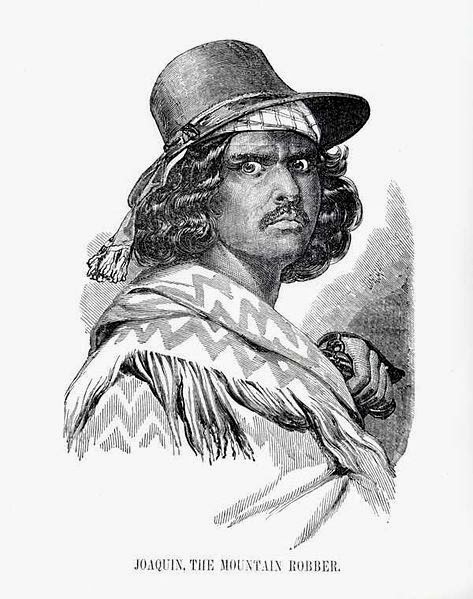By Jessica Knauss
 |
| From the 1990's series Zorro, the most colorful, cheesy incarnation of the legend (and my guilty pleasure) |
I feared it would be difficult to think of freedom fighters
I would enjoy writing about. I focus on medieval Spain, and records for
actual freedom fighters in that time and place are few, and none of them successful.
Then I remembered that one of my favorite characters of all
time is a Hispanic freedom fighter. A fictional compilation of several stirring
figures, Zorro successfully fights for freedom in my home state of California, and
is well educated, skillful, and charming in all his many incarnations.
 |
| Wikimedia Commons. |
Three historical personages may have inspired Johnston
McCulley’s 1919 serialized novel The
Curse of Capistrano, which spawned all the movies, series, and later books.
 |
| Terrifying portrait of Joaquín Murrieta that appeared posthumously in the Sacramento newspaper. Wikimedia Commons. |
Joaquín Murrieta (c. 1829 - c. 1853) was a Mexican national who came to California during the gold rush. Legends and dime novels sprouted up after his death, making it difficult to discern the truth about his life. The most certain fact is that his actions (“outlawry”) made the new State of California very upset and spurred the incorporation of the California rangers. They hunted down and killed three men, one of whom may have been Murrieta. Murrieta’s presumed head then became part of a strange continuation of medieval relic worship. After serving as proof of Murrieta’s death so the rangers could receive the reward money, the head was preserved in brine and displayed for paying customers. Today, some people interpret Murrieta’s bandidos and their alleged marauding as resistance to Anglo dominance in California and an attempt to recuperate for Mexico the territories lost via the Treaty of Guadalupe Hidalgo. The 1998 movie The Mask of Zorro pays tribute to Murrieta’s contribution to the
Zorro legend by naming the main character Alejandro Murrieta.
 |
| Statue of Hidalgo in Coyoacán (D. F.), México. Wikimedia Commons. |
An earlier (and less likely) possibility for inspiration for
the Zorro character is Father Manuel Hidalgo y Costilla (1753 – 1811). The most widely recognized freedom fighter in this group, Hidalgo gave the
speech known as the Grito de Dolores
during Mass on September 16, 1810, calling on the people to overthrow the
Napoleonic government and restore the Spanish monarchy in Mexico. A national
hero, he needs no more explanation, but in this context, it’s worth noting that
his sharp wit merited him the nickname El
Zorro (the Fox) and, like our fictional character, he supported the Spanish
monarchy against perceived foreign encroachment in Mexican (or former Mexican)
territory.
The most fascinating possible real-life Zorro is William Lamport (1615 - 1659), an Irishman who fought for indigenous rights
in Mexico. Vicente Riva Palacio wrote a novel about Lamport in 1872 that could
easily have influenced McCulley’s first Zorro book. The Irish Zorro by Gerard Ronan is the 2004 biography
of this unique figure. What is it about the seventeenth century that it
produced such learned swashbucklers? Always clever (like a fox), Lamport is
said to have spoken at least fourteen languages fluently, but never seemed to
know when to keep his mouth shut. He fled the British Isles, where he had been
sowing sedition and his wild oats, to spend some time as a pirate and end up at
the Spanish court. The Conde-Duque de Olivares, the most powerful man in Spain
at the time, sent Lamport to Mexico as a spy. While there, he took at least one
noble lover and came to sympathize with the enslaved Indians. He’s said to have
written the first declaration of independence in the Indies. This document
promised land reform, equality of opportunity, racial equality and a democratically
elected monarch more than a century before the French Revolution. Lamport was
imprisoned for plotting against Spain and escaped for two days, during which he
plastered Mexico City with anti-Inquisition pamphlets. The Inquisition later burned
him at the stake as a heretic, but it’s said he resisted to the end, strangling
himself before the flames could take him.
In spite of my consuming interest in history related to Spain, I might never have known about these extraordinary freedom fighters if it hadn’t been for the fictional character they (could have) inspired. I doubt Johnston McCulley had anything on his mind beyond profiting from writing, but inadvertently, he ensured the legacies of Murrieta, Hidalgo, and Lamport would live on.
In spite of my consuming interest in history related to Spain, I might never have known about these extraordinary freedom fighters if it hadn’t been for the fictional character they (could have) inspired. I doubt Johnston McCulley had anything on his mind beyond profiting from writing, but inadvertently, he ensured the legacies of Murrieta, Hidalgo, and Lamport would live on.
A driven fiction writer, Jessica Knauss has edited many fine historical novels and is currently a bilingual proofreader at an educational publisher. Find out more about her historical novel, Seven Noble Knights, and her other writing and bookish activities here. Follow her on Facebook and Twitter, too!
